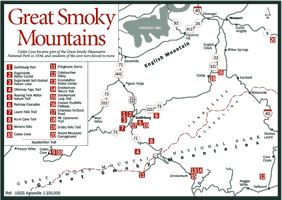
Among the fauna found within the park are 50 mammals, 200 birds, 70 fish, and 80 reptiles and amphibians. The black bear attracts the most attention from visitors. White-tailed deer and wild turkeys are numerous, and along streams and rivers, it's not unusual to see river otters (Lutra canadensis) and mink (Mustela vision). Beaver (Castor canadensis) are being seen occasionally.
Groundhogs (Marmota monax), opossums (Didelphis marsupialis), cottontail rabbits (Sylvilagus floridanus), skunks (Mephitis mephitis), long-tailed weasels (Mustela freneta), gray (Urocyon cinereoargenteus) and red (Vulpes fulva) foxes, and bobcats (Lynx rufus) are commonly seen in coves and other open areas. The red wolf (Canis rufus) once roamed the Southeast, but is now one of the most endangered mammals on earth. In 1991, the U.S. Fish and Wildlife Service and Great Smoky Mountains National Park began an experimental red wolf recovery plan with a pair of red wolves obtained from captive breeding programs, but the restoration was not successful and was abandoned in 1998 for various reasons.
Gray squirrels (Sciurus carolinensis), fox squirrels (Sciurus niger), southern flying squirrels (Glaucomys volans), northern flying squirrels (Glaucomys sabrinis), and red squirrels (Tamiasciurus hudsonicus) are common throughout both the hardwood and coniferous forests. There are numerous members of the mouse family present as well as shrews and moles.
Other than the Eastern wild turkey, the birds visitors are most likely to see or hear include the dark-eyed junco (Junco hyemalis), crow (Corvus brachyrhynchos), raven (Corvus corax), red breasted nuthatch (Sitta canadensis), black-capped chickadee (Parus atricapillus), barred owl (Strix varia), Eastern phoebe (Sayornis phoebe), tufted titmouse (Parus bicolor), ruffed grouse (Bonasa umbellus), red-eyed vireo (Vireo olivaceus), Carolina wren (Thyrothorus ludovicianus), Carolina chickadee (Parus carolinensis), song sparrow (Melospiza melodia), veery (Catharus fuscescens), wood thrush (Hylocichla mustelina), golden-crowned kinglet (Regulus satrapa), Indigo bunting (Passerina cyanea), northern cardinal (Cardinalis cardinalis), rufous-sided towhee (Pipilo erythrophthalmus), scarlet tanager (Piranga olivacea), and American goldfinch (Carduelis tristis).
There are about 60 species of birds that reside within the park, and annual Christmas bird counts generally number about 65 species on an average day. During spring migrations, the numbers jump closer to 100 species per day. The peregrine falcon (Falco peregrinis) is back after an absence of about 50 years.
Snakes are not uncommon in the park, but nonpoisonous species by far outnumber the poisonous kind. The ones to avoid are the timber rattlesnake (Crotalus horridus) and the copperhead (Agkistrodon contortrix mokasen). Rattlers like rocky, warm slopes, and copperheads frequent rocky places and areas around old buildings. Rattlesnakes are seldom seen at the higher elevations, and copperheads usually are below the 2,500-foot level.